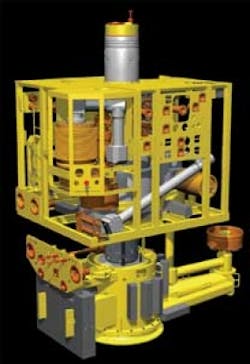Marcio R. Mello, Nilo C. Azambuja Filho, Eduardo de Mio, André A. Bender, Carlos Luciano. C. de Jesus, Priscila Schmitt - HRT & Petroleum
In the past three years, four of the eight biggest oil discoveries in the world were in the deepwater Santos basin of southern Brazil, which includes the Tupi, Iara, Jupiter, and Guara oil fields. This area encompasses several other successfully tested prospects such as Bem-te-Vi, Carioca, and Parati fields. Volumes are surprisingly large; up to 18 Bbbls of oil. Such discoveries emphasize that exploration has just begun in most of the ultra deepwater of the Greater Campos basin of Brazil’s southern margin.A 3D integrated petroleum system model using a geological and geophysical framework was built on detailed mapping of 20,000 sq km (7,722 sq mi) of PSDM (prestack depth migration) seismic data from CGGVeritas. The 3D basin model used information about source rocks richness, thickness, distribution, kerogen kinetics, reservoir quality, sealing rocks, and trap geometries. Also, the temperature and pressure conditions of light oil and condensates trapped below the salt layer were predicted and helped calibrate the model.
Based on those calibrations, a fully integrated petroleum system simulation with PetroMod 3D (provided by IES) was used to evaluate interplay among the elements and processes of the petroleum system to assess source rock potential (vertical and horizontal distribution), thermal evolution of the source rocks, transformation ratio, hydrocarbon generation and charge, timing of migration, oil origin, quality, and volume of petroleum in the main reservoirs. A detailed facies model from the presalt section was built based on well data and conceptual models from seismic interpretation associated with previous knowledge of the tectono-sedimentary sequences of the Santos basin.
The predicted vitrinite map, integrated with all data, indicates that the Coquinas SR in most of the eastern half area is in the main oil window, whereas the western half is in the late oil/wet gas generation window. In terms of transformation ratio, the Barremian and Aptian source rock systems in the area reached 70% to 80% today where the main depocenters are (Mello et al., 2009).
Two physical parameters were critical in the exceptional thermal conditions for the overcharged oil generation and its preservation in the Santos giant oil province:
- 1. The heat flow history
- 2. The high average thermal conductivity of the evaporitic layers.
Contrary to theoretical model prediction of high heat flow values in ultra deepwater (e.g. McKenzie type of models), the heat flow peak never exceeded 120 mW/m2. Additionally, the volcanoclastics stratified in the presalt sequences so far are neither a risk in terms of high temperature intrusive nor reservoir or source rock quality (Mello et al., 2009).
Predicted temperature values in the main source rock deposited in a lacustrine brackish to saline alkaline lake environment, such as the Aptian calcareous and the Barremian black shales, (e.g. Coquinas and Talk Stevensite section in the Campos basin [Mello, et al., 1995; Dias 2004; Mello et al., 1995 and 2009]) range from 90° to 130° C (194° to 266° F) in the deepest part of the basin to 70° to 90° C (158° to 194° F) in the shallowest areas. Such values are critical not only to preserve the oil-prone nature of the whole area, but also to preserve the permoporosity and reservoirs temperatures (Mello et al., 2009).
In general, the pressure behavior reflects the structural discontinuity of the halite salt core of the evaporitic sequence, which allowed pressure release in the presalt layers to reach normal pressure values for most of the area. Excess pressure is surprisingly low in the presalt rocks. The highest excess pressure values are less than 0.2 MPa (29 psi) in local depocenters and are at hydrostatic state over most of the area (Mello et al., 2009).
However, the main exploration and production risk lies in the nature and petrophysical characteristics of the reservoir rocks – alternating microbiolites, stromatolites, coquinas, and volcaniclastics and sum of more than 400 m (1,312 ft) in thickness and extend for more than 1,500 km (932 mi) from southern Santos to northern Espírito Santo basins, presenting porosities from 8% to 20% and permeability from 20 md to 500 md (Mello et al., 2009).
The charge and accumulation simulation model for the presalt province suggests a potential reserve in the Cluster area of Santos basin much larger than that reported, getting numbers to 60 Bbbls of oil reserves. The discoveries are of light oil (31° to 37° API) with low sulfur and are lacustrine in origin.
The supergiant accumulations of light oil, condensate, and gas found in the Tupi, Carioca, Parati, Guara, Iara, Bem-Te-Vi, and Jupiter study areas are trapped below a huge evaporitic sequence that can hold significant hydrocarbon column heights, a key to establishing one of the most prolific petroleum systems of the world: The Great Lagoa Feia Petroleum System (Mello, et al., 1995 and 2009).
All volumetric estimations are based on the premise that the same permoporosity distributions exist for all the stromatolites, coquinas, and clastic basal reservoirs.
Acknowledgments
The authors thank CCG-VERITAS for the 3D seismic data for the 3D Petroleum System and Exploration Risk Assessment Multiclient study performed by HRT & Petroleum in association with CGGVeritas. The authors are grateful to geophysicists Alexandre Coelho and Paula Kale Brazão, and the HRT personnel who cooperated in this project. We also thank IES for the PetroMod 3D.
References
FORMIGLI, J. 2008. Santos basin Pre-salt cluster: how to make production development technical and economically feasible. Rio O.il & Gas.
MELLO, M. R., TELNAES, N. J. R. MAXWELL. 1995. The hydrocarbon source potential in the Brazilian Marginal Basins: a geochemical and Paleoenvironmental Assessment, in A. Y. Huc, ed., paleogeography, paleoclimate and source rocks: AAPG Studies in Geology, v. 40: Tulsa, AAPG, p. 233-272.
MELLO, M. R., AZAMBUJA FILHO, N.C., BENDER, A., BRUNO. P.S., DE MIO, E., CATTO, A. J., SCHMIT, P., JESUS, C.L. 2009. The super-Giant Discoveries in the Pre-salt Hydrocarbon Province of Santos Basin. Submitted to AAPG bulletin.











